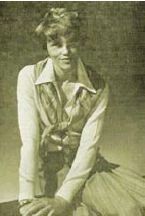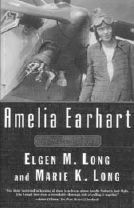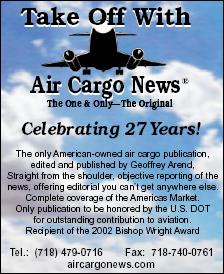|
You are currently
in the Archives section. Please be aware that some information and links
in the archived page may be outdated.
Click here
to return to the Archives' main page to see the list of archived articles.
|
A
R C H I V E S
BOOKSHELF
Amelia Earhart
 Amelia
Earhart, the most famous female aviator in history was born in Atchison,
Kansas, in 1897. Amelia
Earhart, the most famous female aviator in history was born in Atchison,
Kansas, in 1897.
She took flying lessons in a Curtiss
Jenny, receiving her pilot’s license in 1921.
Later, while working at the Denison
Settlement house in Boston, she was invited to fly as a passenger
across the Atlantic Ocean.
This dramatic 1928 flight in the Fokker
“Friendship” as the first woman passenger to make the crossing in
history with pilots Stultz and Gordon, brought her international attention
and the opportunity to earn a living in aviation. After the flight,
she entered air competitions placing third in the All-Women’s Air
Derby of 1929, a race she had organized.
Her own nonstop solo flight across the
Atlantic on May 20-21, 1932, the first for a woman, in the blood red
Lockheed Vega 5B (located in the Pioneers of Flight gallery at the
National Air & Space Museum) established her reputation as a great
female pilot.
Other record Amelia Earhart flights
include: the first solo transcontinental flight by a woman from Los
Angeles to Newark in 1932, the first solo flight by anyone from Hawaii
to the U.S. mainland in 1935, the first nonstop flight from Mexico
City to Newark in May 1935, and the first altitude record in the Pitcairn
Autogiro.
Amelia Earhart was much more than a
seat-of-the-pants flier.
She made her own way in a time when
women were scarce and few, in the field of flying.
She was beautiful and also uniquely
American with an infectious grin that captured the hearts and imagination
of people around the world.
But she put her fame to good use as
a founding member and president of the Ninety-Nines (the original
women pilots organization), partner in the Transcontinental Air Transport
and Ludington airlines, and a designer of clothes and luggage.
She lectured across the country about
aviation and women’s issues and published several books.
She was also a visiting professor and
counselor at Purdue University.
Miss Earhart was a two-time Harmon Trophy
winner and also won the U.S. Distinguished Flying Cross.
On June 1, 1937, Amelia Earhart began
an around-the-world flight from Miami, Florida (from a small field
near MIA International—her aircraft’s hangar is still there in daily
use as parking garage for Metro-Dade vehicles) in a twin-engine Lockheed
Electra with Fred Noonan (who had gained fame doing the same thing
aboard Pan Am China Clipper two years prior) as her navigator.
They reached New Guinea on June 29,
having flown 22,000 miles.
Full of hope, without a doubt in the
world, they departed Lae for the Howland Islands and with less than
7,000 miles left to fly were never heard from again.
Earhart and Noonan were declared lost
at sea on July 18, 1937 following a massive sea and air search ordered
personally by President Roosevelt.
Amelia Earhart’s disappearance unfortunately
is what is still talked about when her name is mentioned today.
But her true legacy as a courageous
and dedicated aviator and an inspiration to women is what should be
remembered.
In 2003, as aviation celebrates 100
years, interest in the first lady of the air continues.
The family of Ms. Earhart has put up
an excellent website allowing visitors the complete package including
great photos plus other items including directions to the scores of
books about the great pioneer. www.ameliaearhart.com.
 Excellent
book titled “Amelia Earhart, The Mystery Solved” by Elgin and Marie
Long (Simon & Schuster Pub. Date: November 4, 1999 Price $25.00 ISBN:
0-684-86005-8 should be the first literary port of call for everyone
interested in the life and times of Amelia Earhart. Excellent
book titled “Amelia Earhart, The Mystery Solved” by Elgin and Marie
Long (Simon & Schuster Pub. Date: November 4, 1999 Price $25.00 ISBN:
0-684-86005-8 should be the first literary port of call for everyone
interested in the life and times of Amelia Earhart.
Incidentally the author, Captain Long
went to work for Bob Prescott’s Flying Tiger Line when the company
was launched in 1947 where he worked as a pilot hauling dynamite to
Canada.
He flew for the all-cargo carrier until
1990, flying every aircraft the carrier had, and then retiring when
FTL was acquired in a stock deal by Federal Express.
The thing that makes Mr. Long’s book
about Amelia so compelling is that here is one of the great pioneering
pilots both in air cargo and in exploration in both polar regions
during the 1950’s through the 1970’s.
He is most noted for the flying that
he did in the 1950’s in establishing the Distant Early Warnings across
Northern Canada’s Arctic Coastline.
Captain Long is a walking history book
on the effort because it was a top-secret effort at the time and little
has been publicly recorded.
He also is the only pilot to have flown
solo around the world over the poles (he flew in a Piper Navajo).
For this he received the Gold Medal
from the Federation Aeronautique Internationale (the world’s premier
award for exploration by air) thereby joining only nine other Americans,
including the Wright Brothers, Jimmy Doolittle and Chuck Yeager, who
have won this award. |
|

|


